The USSR Pavilion
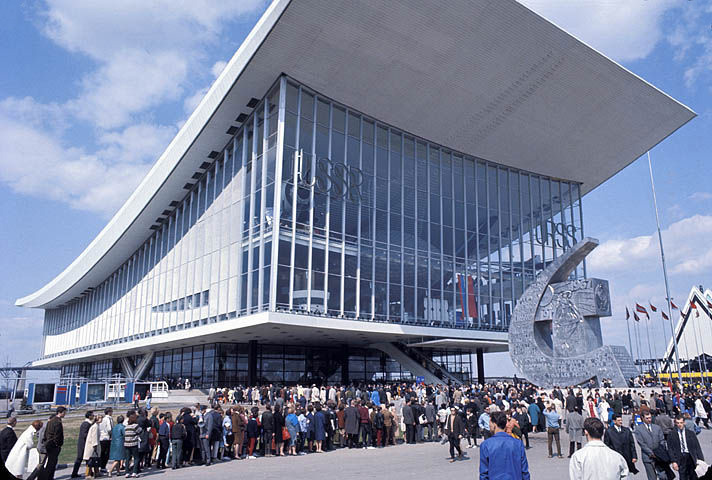 Located on Île Notre Dame, the USSR pavilion was one of the largest at Expo 67. And with an attendance of 15 million, it was the most visited.
Located on Île Notre Dame, the USSR pavilion was one of the largest at Expo 67. And with an attendance of 15 million, it was the most visited.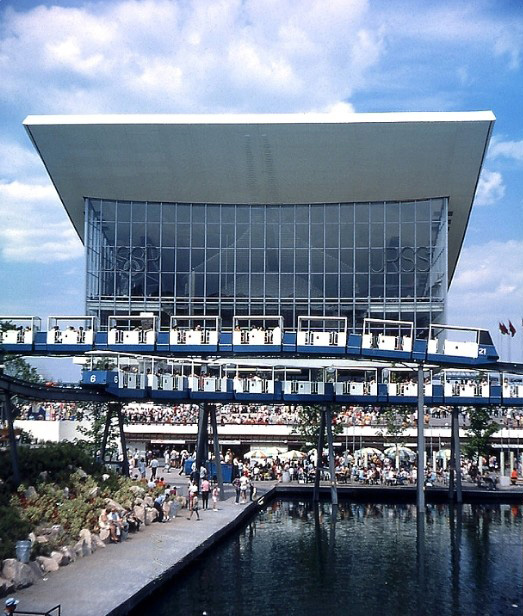 The striking structure of glass and aluminium featured a dramatic sweeping roof, meant to symbolize the country's powerful take off. The bold USSR/URSS lettering on the pavilions facade drew crowds curious to discover the mystique of the Soviet Union.
The striking structure of glass and aluminium featured a dramatic sweeping roof, meant to symbolize the country's powerful take off. The bold USSR/URSS lettering on the pavilions facade drew crowds curious to discover the mystique of the Soviet Union. This sculpture paid hommage to the 50th anniversary of the Russian revolution.
This sculpture paid hommage to the 50th anniversary of the Russian revolution.The pavilion's exhibit was based on the elements Earth, Sea and Sky, and how the Soviet population had benefited from these elements "all in the name of man, for the good of man".
Earth was located on the main floor, Sea was one floor below, while Sky, with it's hugely popular space exhibit, was strategically located on a mezzanine at the highest point of the pavilion.
Earth
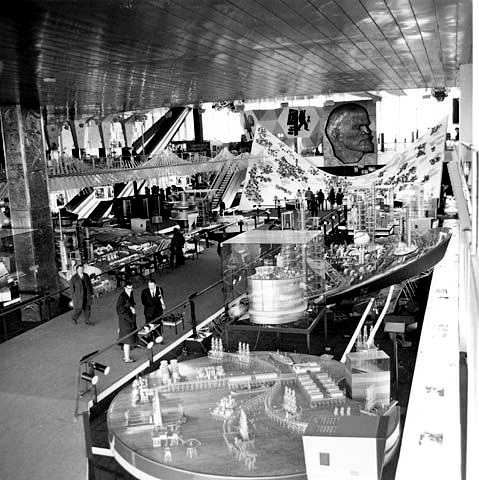 A huge portrait of Lenin hung high above the Earth section, where the raw material wealth of the country was displayed. Films, photographs, illuminated maps, sketches and texts, as well as models, machines and samples of raw materials all sought to demonstrate Soviet achievements and future plans in such diverse fields as consumer goods industries, oil and coal industries, housing and town planning, agriculture, chemistry, mechanical engineering, quantum electronics, etc. etc...
A huge portrait of Lenin hung high above the Earth section, where the raw material wealth of the country was displayed. Films, photographs, illuminated maps, sketches and texts, as well as models, machines and samples of raw materials all sought to demonstrate Soviet achievements and future plans in such diverse fields as consumer goods industries, oil and coal industries, housing and town planning, agriculture, chemistry, mechanical engineering, quantum electronics, etc. etc...Sea
 Sturgeon (the fish that produce caviar) swam peacefully up and down a large fish pool located in the Sea section. Ship models were on display in this section, including the atomic icebreaker Lenin. A model of a desalinization plant showed how fresh water was produced.
Sturgeon (the fish that produce caviar) swam peacefully up and down a large fish pool located in the Sea section. Ship models were on display in this section, including the atomic icebreaker Lenin. A model of a desalinization plant showed how fresh water was produced.Sky
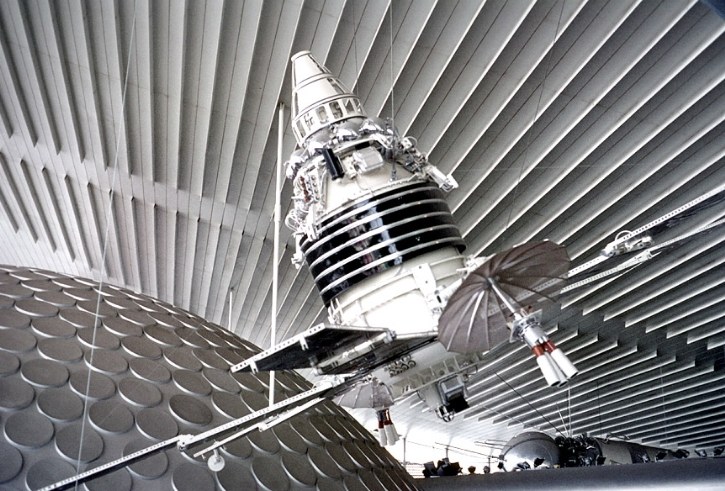 High under the roof, a gallery was devoted to the conquest of space. On either side of the section were huge impressionistic panels of blues, greens and purples, painted by Alexi Leonov, the first man to walk in space. Cosmos Hall was a spherical 60-seat theatre which took visitors on a simulated ride to outer space. A replica of Yuri Gagarin's space capsule was on display, as were mock-ups of the surfaces of the moon and Venus.
High under the roof, a gallery was devoted to the conquest of space. On either side of the section were huge impressionistic panels of blues, greens and purples, painted by Alexi Leonov, the first man to walk in space. Cosmos Hall was a spherical 60-seat theatre which took visitors on a simulated ride to outer space. A replica of Yuri Gagarin's space capsule was on display, as were mock-ups of the surfaces of the moon and Venus.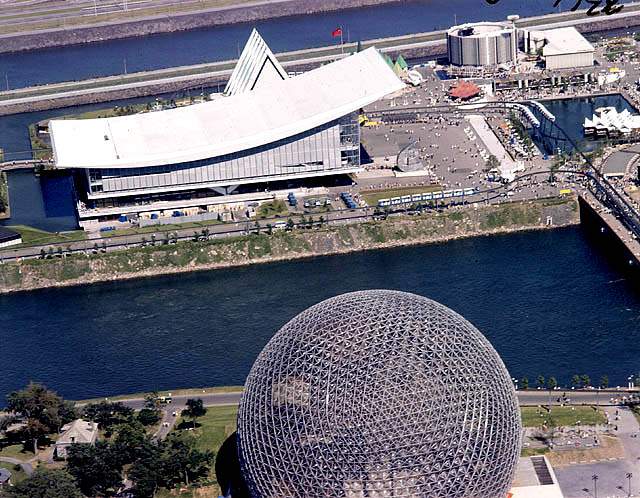 Due to the Cold War, the USSR's position adjacent to the US pavilion raised eyebrows.
Due to the Cold War, the USSR's position adjacent to the US pavilion raised eyebrows. The USSR pavilion was also equipped with a 600-seat theatre, used for movies, documentaries and fashion shows. A wide variety of Russian delicacies could be sampled at the pavilion's café, snack bar and 1100-seat Moskva restaurant.
 An official postcard featuring the impressive USSR pavilion facade at dusk.
An official postcard featuring the impressive USSR pavilion facade at dusk.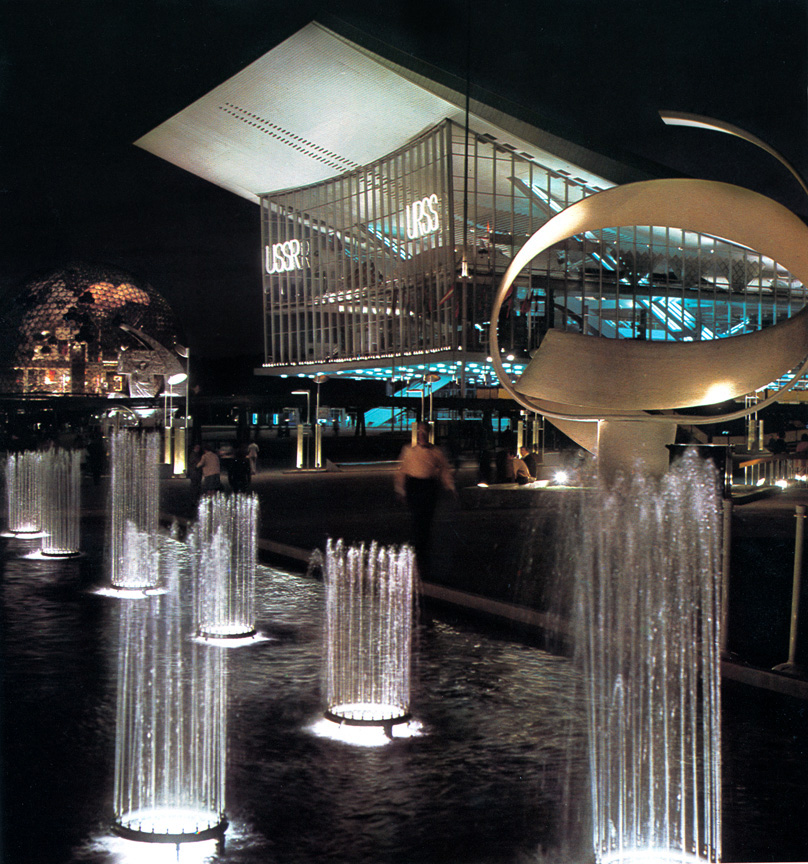 A stunning view of the USSR pavilion at night.
A stunning view of the USSR pavilion at night.images: (1-2-3-4-6-7) library and archives Canada
(5) expo67.ncf.ca
(8) alamedainfo.com
(9) courtesy DC Hillier
Labels: pavilions-a-gogo

0 Comments:
Post a Comment